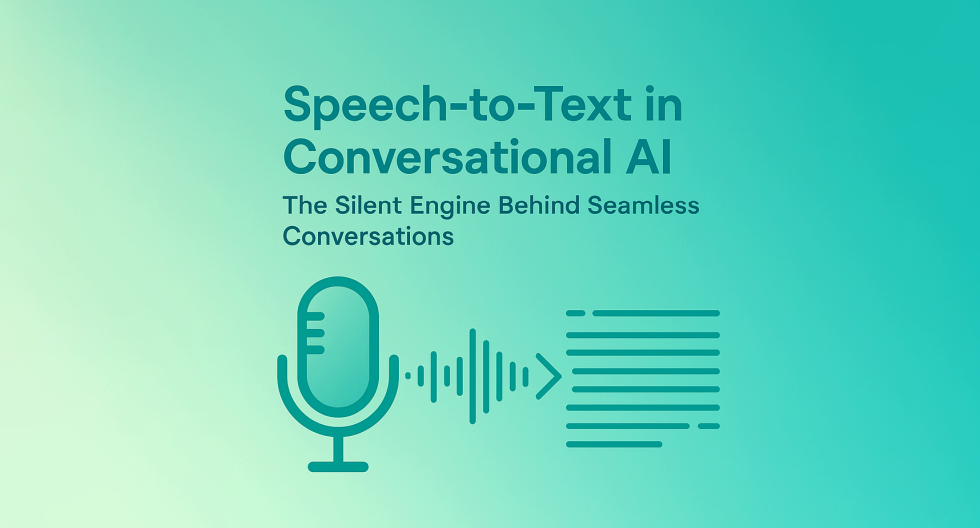Speech-to-Text in Conversational AI: The Silent Engine Behind Seamless Conversations

In voice-based conversational AI, the journey from spoken word to intelligent response begins with one crucial component: Speech-to-Text (STT). Also called automatic speech recognition (ASR), it converts audio into machine-readable text.
Though STT might seem simple, achieving real-time, low-latency transcription in multiple languages is one of the hardest challenges in voice AI. This blog explores how STT powers today's assistants, compares top providers, and previews what's coming next in 2025.
Key Insight
Speech-to-text (STT) is the foundational input layer of voice AI. This blog explores how STT works, compares the top providers, and outlines the tradeoffs between latency, accuracy, and privacy in real-time speech interfaces.
Why Speech-to-Text Matters
Every voice interaction starts with STT. It’s the input gateway. But this gateway must be fast and accurate — and those two goals often conflict.
- Low latency can reduce transcription quality.
- High accuracy often introduces delay.
In real-time systems like voice agents or call automation, even a 300 ms delay can feel sluggish. Ideal time-to-first-token (TTFT) is under 250 ms. Over 500 ms, and the experience breaks down.
Core Components
- Accuracy vs Latency Tradeoff STT models must balance high transcription accuracy with low response time to enable smooth conversational experiences.
- Top STT Providers Vendors like Deepgram, Gladia, and Speechmatics offer production-ready APIs with different latency and privacy models.
- LLM Integration Large language models can compensate for transcription errors by reasoning over context and intent.
- Streaming vs Batch Use Cases Whisper and cloud APIs are better suited for non-real-time use, while platforms like Deepgram and Gladia support streaming.
- Privacy & Residency Considerations On-premise or EU-compliant hosting becomes essential when data residency or regulation is a factor.
Top STT Providers in 2025
🔹 Deepgram
Deepgram is a mature STT provider offering ~150 ms TTFT in the US and ~250–350 ms globally.
- Great balance of cost, accuracy, and speed
- On-premise Docker deployment available
- Supports domain-specific model fine-tuning
- ⚠️ May use your data for model improvement unless opted out
🔹 Gladia
Gladia has emerged as a go-to platform for multilingual voice AI, with support for 100+ languages and servers in Europe and the US.
- Fully EU privacy compliant
- Excellent for non-English transcription
- Hosted and self-hosted options available
📉 Whisper by OpenAI
Whisper is powerful and open source, but slow:
- TTFT typically 500 ms+
- Not suited for responsive voice agents
- Best for offline transcription or batch jobs
Note: Some vendors (e.g., Groq) have accelerated Whisper below 300 ms using custom hardware.
Implementation Roadmap
- 1Select a suitable STT engine based on your latency, accuracy, and language requirements
- 2Measure word error rate (WER) and time-to-first-token (TTFT) in real scenarios
- 3Use streaming APIs for voice agents; batch for offline analysis
- 4Integrate LLM prompting to correct potential ASR errors in downstream NLP
- 5Host models on-premise if privacy or compliance demands it
LLM Prompting to Fix STT Errors
Modern large language models can “reason through” poor transcriptions. Example:
Transcription: “buy milk two tomorrow”
Intended: “buy milk tomorrow”
With context-aware prompting, LLMs can correct small ASR glitches — improving intent recognition and response accuracy without needing perfect transcription.
New Innovations in STT (2025)
- GPT‑4o‑Transcribe: Fast but experimental for real-time use
- Groq + Whisper Turbo: Sub‑300 ms TTFT with hardware acceleration
- NVIDIA Speech: Open-source, optimized for ONNX + Triton
- Speechmatics & AssemblyAI: Competitive low-latency streaming APIs
⚙️ Hybrid Architectures
Some voice agents now run parallel LLM and STT pipelines using tools like Gemini 2.0 Flash. This setup allows early transcription and simultaneous response generation — reducing latency while improving transcript quality.
Privacy and Data Residency
In regulated sectors (e.g., finance, healthcare) or specific regions (e.g., EU, India), transcription privacy and sovereignty matter. Consider:
- On-premise hosting with Deepgram or Gladia
- Ensuring no training usage of user data
- Signing BAAs or DPAs when required
The Road Ahead
As STT systems improve:
- Sub-200 ms TTFT is becoming viable
- Multilingual support is now standard
- LLMs enhance resilience to ASR errors
- Edge inference brings transcription closer to users
Conclusion
Speech-to-text isn’t just the first step — it’s the foundation of every voice AI experience. The provider you choose, how you deploy it, and how you handle latency and privacy will shape how your users interact with your AI.
Whether you go with Deepgram for reliability, Gladia for multilingual coverage, or experimental LLM-STT combos — remember: every millisecond and every word counts.
Links are rel="nofollow" as per policy.
Ready to Transform Your Customer Service?
Discover how Zoice's conversation intelligence platform can help you enhance CLV and build lasting customer loyalty.